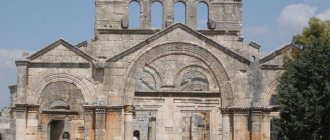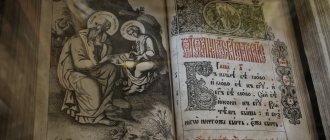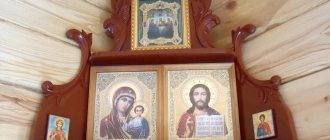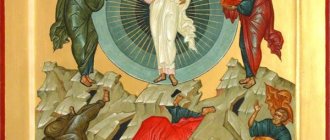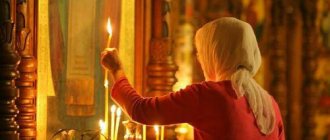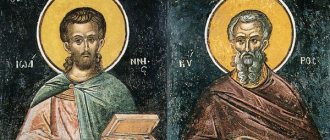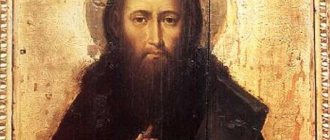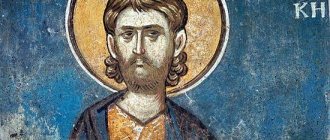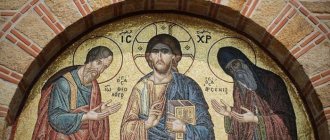One cannot help but be amazed by the history of the spring of Simeon of Verkhoturye. In 1692, in the Urals, in the village of Merkushino, fifty miles from the city of Verkhoturye (Perm province), a coffin with the relics of an unknown person rose from a grave and stood on top of it.
The cause of this extraordinary phenomenon turned out to be a source that suddenly gushed from below the burial site. The miracles that took place at the relics convinced everyone that the person lying in the tomb was a true saint of God. The local bishop, Metropolitan Ignatius of Tobolsk, having examined the relics, ordered all the people to pray for the revelation of this secret and was miraculously informed of the name of the deceased righteous man: “His name is Simeon! Call him Simeon! Thus, by the will of the Almighty, a saint unknown to anyone during his lifetime was glorified - the righteous Simeon of Verkhoturye.
How does Simeon Verkhotursky help? The spring is known for many miracles.
Day of Simeon of Verkhoturye (Merkushinsky) falls on September 12 and December 18
Prayer for vision healing
The prayers are written down into short paragraphs for easier memorization!
“Oh, holy and righteous Simeon, with your pure soul in the heavenly abodes in the face of the saints, rest on earth with your incorruptible body, according to the grace given to you from the Lord, pray for us.
Mercifully look upon us, many sinners, even if we are unworthy, but with faith and hope in your holy and wholesome power flowing, and ask us from God for forgiveness of our sins, in which we fall in multitudes all the days of our life.
And just as before, to those who suffered from green diseases, they were able to heal their eyes, to those who were near death from severe ailments, and to others you bestowed many other glorious blessings:
so deliver us from mental and physical ailments and from all sorrow and sorrow, and ask from the Lord all that is good for our present life and eternal salvation that is beneficial to us, so that through your intercession and prayers you have acquired everything useful to us, even if unworthy,
Gratefully praising you, let us glorify God, wondrous in His saints, the Father and the Son and the Holy Spirit, now and ever and unto ages of ages. Amen."
Description
In this ancient masterpiece of Orthodox icon painting, which belongs to the iconographic type of the 19th century, the righteous man is depicted in a blue caftan and with a prayer scroll in his left hand against the backdrop of the beautiful nature of his native taiga.
- A small church chapel can be seen nearby, as a reminder of the saint’s modesty. At the top is an image of Christ, who blesses Simeon for spiritual deeds.
- His image on the icon is striking in its simplicity, purity and sincerity: in it he is eternally young, kind, radiating joy and love for his neighbor. The contemplation of a saint in such a guise is very attractive, bringing peace, tranquility and faith in the best.
- On the scroll in Simeon’s hand you can read the inscription: “I pray you, brothers, have the fear of God and purity of soul and body.” With these words, he calls everyone to take the righteous path, which will lead to eternal Heavenly peace and happiness.
The icon, like the holy righteous Simeon of Verkhoturye himself, has gone through an interesting and long history. It is also noteworthy that, being over 100 years old, it has not lost any of its colorfulness and strength. There is also an amazing fact that two icons of St. Simeon of Verkhoturye were among the icons that accompanied the family of Emperor Nicholas II in its wanderings.
Prayers
Troparion to the righteous Simeon of Verkhoturye, for glorification, tone 4
Fleeing worldly rebellion, you turned all your desire to God, / so that in visions of the sunrise you found grief, / not deviating into the wickedness of your heart, / but having cleansed your soul and body, / you received the grace to sharpen the goals of the faithful and the unfaithful, / flowing to you, righteous Simeon./ Also, according to the gift given to you,/ ask Christ God for healing for us who are sick with spiritual passions, // and pray to save our souls.
Translation: Avoiding the vanity of the world, you turned all your aspiration to God, and, ascending in contemplation high to heaven, from there you did not turn your heart to the evil one, but, having purified your soul and body, you accepted the grace to give healing to believers and non-believers who come to you, righteous Simeon. Therefore, according to the gift given to you, ask Christ God for healing for us who are sick with spiritual passions, and pray for the salvation of our souls.
Troparion to the righteous Simeon of Verkhoturye, for the transfer of relics, tone 4
Today the glorious country of Siberia rejoices, / has found your holy relics within itself. / The bishops, priests and the whole host of people / spiritually rejoicing, cry out to you: / about the God-wise Simeon! / Deliver us, those who come running to you, from all troubles, / asking for submission to everyone according to each request, / and deliver this country and the city / from the fiery incineration and the filthy invasion / and internecine warfare and from all evil./
In the same way, we all now honor the offering of your honorable and multi-healing relics,/ a new healer, and we cry // glory to Him who gives healing to you all!
Translation: Today the glorious land of Siberia rejoices, having acquired your holy relics. Bishops, priests and many people, having spiritual joy, cry to you: “O God-wise Simeon, deliver us, who come to you, from all troubles, asking you to give everyone what he needs, and to rid this country and city from burning by fire and the invasion of pagans and civil war and from all evil.”
Therefore, we all now honor the transfer of your precious relics, which give many healings, O new healer, and we cry out: “Glory to Him who through you gives healing to everyone!”
Kontakion to the righteous Simeon of Verkhoturye, for glorification, tone 2
You have rejected the vanity of the world,/ so that you may inherit the blessings of eternal life,/ having loved kindness and purity of soul and body./ You have gained what you loved,/ for the tomb and the incorruptibility of your relics testify to this,/ and the grace of miracles most of all./ Sharpen the healing of all flowing to you and the unenlightened,/ Blessed Simeon, // wonder-working wonder.
Translation: Having left the vain world to inherit the blessings of eternal life, having loved kindness and purity of soul and body, you received what you loved, for your coffin and incorruptible relics testify to this, and most of all, the grace of miracles, since you exude healing to all who come to you and those not yet enlightened (by the light of the Gospel), blessed Simeon, amazing miracle worker.
Kontakion to the righteous Simeon of Verkhoturye, for the transfer of relics, tone 4
Today has come the all-honorable memory of the new healer/ righteous Simeon,/ and people are convening to the most honorable temple of the holy Bishop Nicholas of God,/ where many pious multitudes have joyfully gathered,/ joyfully celebrating the presentation of your honorable and multi-healing relics./
For you have appeared to our city, and to all Siberia, as free medicine, / giving healing to those who come to you with faith, O all-blessed Simeon. / But as you have boldness towards the Lord Christ, / pray to him to save the city and the people praying to you, / moreover, be an intercessor to the Lord / in the days of the invasion of sorrow thy servant, let us call thee // Rejoice, praise to the Siberian country and affirmation to our city.
Translation: Today has come the universally revered day of remembrance of the new healer, the righteous Simeon, a holiday that gathers people to the venerable church of the Holy Bishop Nicholas of God, where, joyfully meeting many pious Christians, they cheerfully celebrate the feast of the transfer of your revered and giving many healing relics, Simeon.
For you have become a free doctor for our city and all of Siberia, giving healing to those who come to you with faith, blessed Simeon. But as one who has boldness towards the Lord Christ, pray to Him to save the city and the people praying to you, most of all, be an intercessor before the Lord in those days when sorrows come to your servants, so we cry to you: “Rejoice, honor and strengthening for the land of Siberia our city."
Prayer to the righteous Simeon of Verkhoturye
Oh, holy and righteous Simeon, with your pure soul in the heavenly abodes in the face of the saints, dwell constantly with us on earth! According to this grace from the Lord, pray for us, mercifully look upon us, many sinners, even if we are unworthy, but flowing to you with faith and hope, and ask us from God for forgiveness of our sins, we fall into misfortune in multitudes all the days of our life.
And just as before, for those who were sick from the green eye, no less than to see those who were able to heal their eyes, to those who were near death from severe ailments, healing, and to others, you bestowed many other glorious benefits:
Sitsa, deliver us from mental and physical ailments and from all sorrow and sorrow, and ask us from the Lord for all that is good for our present life and for eternal salvation, so that through your intercession and prayers you have acquired all that is useful to us,
Even though we are unworthy, we praise you with gratitude, let us glorify God, wondrous in His saints, the Father, and the Son, and the Holy Spirit, now and ever and unto the ages of ages. Amen.
Life of a Saint
Simeon was born into a family of pious people outside of Siberia around the beginning of the 17th century. Having matured, he left for Siberia in the Verkhoturye region. At that time, Verkhoturye was known as a trading place, and Simeon could not lead a quiet life there.
Therefore, he begins to live in the village of Merkushino. It was this place that was conducive to the thought of God and hermitic labors. Very often he went to nearby villages and villages for greater solitude with God.
In his free time from prayers, he was engaged in sewing fur coats. In the summer, he fished. The name of the saint became more and more famous. He also went to the houses of peasants and worked for them. Often he had to endure a lot, but he endured all the hardships.
Often the saint did not complete his work so that he would not be paid. Many people condemned him for this, but then people understood why he did this. Simeon often spent his time in prayer. In the summer I fished, and in the winter I sewed fur coats
The life of Simeon of Verkhoturye was distinguished by special humility. Born into a fairly wealthy family and of noble origin, from the very beginning of his adult life he chose the path of a hermit and wanderer.
The main aspect of his Christian feat can be called the so-called “social simplification,” when a person does not divide people into classes and does not identify himself with any of them. Everyone is equal before God and has equal rights. And if the Lord is in the soul, then it makes no difference who is who, the main thing is righteous faith, unshakable and unshakable.
After the death of his parents, he came to the Urals and settled in Verkhoturye (where his church name later came from), where at that time there were a lot of newly enlightened residents who needed his help and support. There he spent most of his life, hiding his true origins from everyone. Since then, the righteous Simeon of Verkhoturye has been revered as the heavenly patron of the entire Ural land.
The saint was always against an idle lifestyle and taught people to live correctly, according to the laws of God. Also striking was his attitude towards injustice, which often had to do with himself. Having suffered physical and moral humiliation more than once, he remained unbroken and continued to follow his path, because he knew that the Lord himself was with him, and he always felt His protection and love.
The righteous man died in Merkushino (not far from Verkhoutye) in 1642 at the age of 35 and was buried in the cemetery at the local church.
It is believed that even after death Simeon helped people. He often dreamed of sick people and cured their illnesses, saved people from the vice of drunkenness...
Righteous Simeon of Verkhoturye (Merkushinsky)
Memorial Days
- February 11 – Cathedral of Ekaterinburg Saints
- May 25 – Second discovery of relics
- June 23 – Cathedral of Siberian Saints
- September 25 – Transfer of relics
- December 31 – Glorification
Life
Veneration of the Saint
On September 12, 1704, with the blessing of Metropolitan Philotheus, the holy relics of the righteous were transferred to the Verkhoturye Monastery. Since that time, it is on this day that the church celebrates the second day of remembrance of the saint (the first is celebrated on December 18).
The memory of the holy righteous Simeon is celebrated on September 12/25 and December 18/31. Thanks to the prayers of the righteous man, the village of Merkushino still stands today, and among the residents there is a legend that Saint Simeon loved to fish during his lifetime. In a secluded place, ten miles from the village, on the banks of the Tura River, a spreading spruce grew.
The saint came there, sat or stood on the shore under a spruce tree with a fishing rod and caught as many fish as he needed for his daily food. While fishing, he internally prayed and reflected on God. This episode from the life of righteous Simeon is often depicted on his icons, in particular on the icon located in the Cathedral of the Nativity of the Mother of God Monastery.
- February 11 – Cathedral of Ekaterinburg Saints
- May 25 – Second discovery of relics
- June 23 – Cathedral of Siberian Saints
- September 25 – Transfer of relics
- December 31 – Glorification
The icon of the righteous Simeon in the frame was transferred to the monastery along with the church property of the parish of the Cathedral of the Nativity of the Blessed Virgin Mary in 1993, upon the abolition of the parish and the opening of the monastery. One of the Moscow priests of the monastery handed over a particle of the saint’s relics. A wooden icon case was made for the icon.
Where are the relics located?
In 1692, the remains of the saint were raised from the grave. His body turned out to be incorrupt, and local residents regarded this as a sign of holiness. The relics of Simeon of Verkhoturye became a real miracle, for they healed from all sorts of misfortunes, including:
- paralysis, skin diseases, eye diseases;
- exorcism;
- cure for drunkenness;
- spiritual consolation and healing;
- protection from negative natural phenomena.
After many examinations, on December 30, 1694, Metropolitan Ignatius transferred them to the church of his native Merkushino, covered the coffin with a silk shroud and gave the order to collect all known information about the life of the righteous, so that his trace would remain in the history of Christianity in the form of a written life and akathist.
In 1604, the Verkhoturye Monastery (Verkhotursky Nikolaevsky, St. Nicholas Monastery) was founded in the same city of Verkhoturye by Hieromonk Jonah from Poshekhonye.
In 1704, the relics of the righteous were transferred to the Nicholas Monastery and placed in a silver shrine. After 12 years, the entire monastery was consumed by fire, but the relics of St. Simeon remained safe and sound.
It is also known that the monastery had a two-class school and an almshouse even before the 1917 revolution. And after 7 years it was closed, and its premises were used as a colony for juvenile delinquents. And only in 1990 the monastery was returned to the Russian Orthodox Church. From the same time, its full resumption began.
Simeon of Verkhoturye is one of the most revered saints of the Russian Orthodox Church. He is an example of a true righteous man, whose life from birth was already given to God. His earthly deeds are truly great and wonderful, for they bestow faith and open the way to the eternal kingdom.
A real treasure of the history and culture of the Orthodox religion, Simeon of Verkhoturye is a miracle worker and a righteous man, a healer of human souls and a great edifier. His blessed simplicity became a model for many who believed in the Lord, because this is where salvation lies.
Re-opening of the relics
On September 25, 1920, on the day of remembrance of the holy righteous Simeon, about fifteen thousand pilgrims arrived at the Verkhoturye monastery. And on this day, local authorities decided to re-open the relics of the great saint of God. A special commission was appointed to commit blasphemy.
The autopsy was intended to be carried out immediately after the end of the liturgy, at approximately one o'clock in the afternoon. However, the monks and priests, led by Archimandrite Xenophon, solemnly and deliberately slowly served the liturgy, followed by a prayer service just as slowly, and an akathist was read after the prayer service... Then the armed Red Army soldiers, in military style, resolutely began to push people out of the cathedral.
The shrine was taken out of the Cathedral of the Exaltation of the Cross onto the porch. Thus began the desecration of the relics of the Verkhoturye miracle worker. His holy relics were subjected to blasphemous dismemberment; they were taken out of the coffin in parts and laid out on the table.
After this, the commission members turned the coffin over and shook out what was left in it onto the table. It was swan down on which the relics rested.
At this time, at the main doors of the cathedral, the monastic archdeacon Benjamin publicly proclaimed: “I ask you not to blaspheme!” On the same day, together with Archimandrite Xenophon, he was arrested and taken to the Yekaterinburg Provincial Cheka.
How did those for whom this whole vile performance was intended - “the dark masses of the populace, intoxicated by the priest’s opium” react? People cried, cried bitterly, did not hide their tears. Some, while crossing themselves, managed to secretly take swan feathers from the table. Fearing outrage from the people, the authorities allowed the holy relics to be returned to the cathedral.
When they failed to publicly discredit Saint Simeon, the Bolsheviks decided to resort to an extremely radical method of struggle - physical elimination. The fact that the righteous man had already died 300 years ago, and the struggle was being waged with human remains, in the miraculous power and immortality of which the new authorities did not believe, did not bother them at all.
Alive, he would not be as dangerous for them as he was deceased. Because during his life he lived like a holy fool, was not known to anyone and in every possible way ran around people with their vain glory, and when he passed away, he began to perform so many miracles and healings that his fame spread throughout Rus' and beyond. Pilgrims continued to go and go to him for help from all over the country, completely neglecting the fact that such behavior of theirs in no way corresponds to the “moral character of a Soviet person.” It was decided to seize and burn the relics of righteous Simeon.
The shrine was indeed confiscated, and only a miracle saved it from the fire. More precisely, the courage of the director of the Nizhny Tagil Museum of Local Lore, Alexander Nikolaevich Slovtsov, who convinced the authorities not to destroy the relics, but to send them to his museum for the purpose of “anti-religious education of the working people.”
However, people did not go to the museum for this at all, but in order to worship the righteous Simeon - pilgrims were ready to pay any money for tickets. When the open pilgrimage began, the relics were removed from the exhibition, and the magazine “Soviet Local History” published a devastating article in which it “convicted” the museum director of religious propaganda. In October 1934, Alexander Nikolaevich was arrested. He died 10 years later in the Khabarovsk forced labor camp.
Reliquary with the relics of the righteous Simeon of Verkhoturye in the St. Nicholas Church of the St. Nicholas Monastery. Verkhoturye (1909)A fighter against his own pride
In winter, the future saint earned his livelihood by sewing fur coats, which local residents ordered for him. In this regard, a very curious recollection of one of the villagers has been preserved, included by Metropolitan Ignatius in the life of the saint he compiled. A witness to those ancient events said that the holy righteous Simeon, wanting to strengthen himself in non-covetousness and develop contempt for vain human praise, often gave the customer a finished fur coat with some minor imperfections, while refusing the payment due for the work.
Thus, he avoided well-deserved praise, which he considered a manifestation of the devilish temptation that gives rise to conceit in the human soul, and accustomed himself to free service to people. It is not without reason that many theologians and church ministers, when asked what the icon of Simeon of Verkhoturye helps with, among other things, do not forget to mention the fight against pride - the sin that nests in the souls of most of us. People cannot overcome this evil without the help of the Higher Powers, and therefore the intercession of the holy saint for them before the Throne of God is extremely valuable.
Relics of the Prophet
As already mentioned, Saint Simeon lived 360 years. There is no exact information about the place of his burial. In Jerusalem, they point to a grave pit in one of the aisles of the Greek church as a possible burial place of the saint. According to other sources, Simeon the God-Receiver was killed during the massacre of the infants, when the king's guards
Herod was interrogated, trying to find out about the whereabouts of Jesus. According to apocryphal legends, after the resurrection of Christ, Simeon, like other righteous people, was resurrected to eternal life.
We advise you to study How the first icons appeared
In the sixth century, his relics were transferred to Constantinople to the Chalcopratian Temple, located at the Copper Gate of the capital of Byzantium. About the veneration of his tomb in 1200. reports Saint Anthony of Novgorod, who made a pilgrimage to the Holy Land.
Currently, in the German city of Aachen, the right hand (right hand) of the saint is kept in a special reliquary casket. You can venerate the shrine only once every seven years, when it is put on display for pilgrims.
The reliquary, made by skilled ancient craftsmen, is a small casket decorated with precious stones, with sculptures of the Virgin Mary and St. Simeon receiving the baby Savior into his hands.
The relics themselves appeared in 1243 in the Croatian city of Zara (Zadar), where they are located in a special sarcophagus in the Church of St. Simeon.
Blessed Merkushino
The road along the Tura River is majestically beautiful: green meadows, hills, vast valleys and the dark greenery of impenetrable forests... But then, after the next bend of the blue ribbon, a sight appears that will take your breath away: gilded crosses burn brighter than the sun against the azure autumn sky domes of Merkushin churches. On the spot where the incorruptible relics were found, the St. Simeon Church rises, and next to it, connected to it by a bright gallery, is the temple in honor of the Archangel Michael. In the middle of the last century, this historical temple complex was destroyed, but in the 90s it was restored in all its former grandeur.
The largest temple - in honor of the Archangel Michael - is so spacious, and its vaults are so high that it seems as if it is woven from light. The dome goes far up, so that when you look up, you even feel dizzy. But the most amazing impression is made by the divine services that take place within these walls: the extraordinary acoustics of the church gives the voices of the singers a special sound. It is difficult to understand where the sound is born, because it fills the entire space, reaches the very dome and pours from somewhere in the sky.
In the ground floor of the Church of the Archangel Michael there is a temple-baptistery - of extraordinary beauty! Daylight does not penetrate there, so there is always twilight. The gilded iconostasis flickers mysteriously in the glow of the lamps. The baptismal font is of impressive size and is lined with mosaic patterns in the Byzantine style.
The throne of this temple is consecrated in honor of the holy martyr Constantine, who was shot in Merkushino during the times of the atheistic regime. It is surprising that the relics of this new martyr lay in the same marshy Siberian soil even longer than the relics of the righteous Simeon - eighty years - but when they were found, they also turned out to be incorruptible. Even the clothes of the murdered priest were untouched by time; his body did not become numb and bent. Truly blessed is the land of Merkushino, which at all times shows the world the holy saints of God!
We recommend studying Psalm 51
relics of the holy martyr Constantine of the Epiphany
No matter how many times I’ve been here, I can never stop admiring these places; my eyes desire, but can never hold, the grandeur of the temple complex in its pristine beauty; my heart aches when I look at the touchingly beautiful nature of these places.
First of all, I go to bow to the tomb of the holy righteous Simeon, to drink water from the healing spring that flows in the place where his coffin appeared on the surface of the earth. The Simeon Temple was built directly above the source. There are places from which you don’t want to leave, one of them is the tomb of the holy righteous Simeon of Verkhoturye: under the gentle gaze of the saint looking at you from the icon, you feel good and cozy, like at home. Now the tomb of the righteous Simeon is a small room lined with marble slabs with a spring in the middle, it is located directly under the altar of the Simeon Temple. Time moves here completely imperceptibly, and sometimes it seems as if it stops altogether, freezes and turns into eternity.
The relics themselves are not in the tomb. They are in Verkhoturye, in the St. Nicholas Monastery, where they were solemnly transferred almost immediately after their discovery - in 1704. Having admired the places dear to my heart, I said goodbye to Merkushino and set off on a further journey to venerate the relics of the righteous. After all, if you didn’t see the owner, then how can you consider that you were visiting.
I had to make several stops along the way. The first is in the place of solitary prayers of the righteous Simeon, it is very close, ten kilometers from Merkushino. A stone has been preserved here, sitting on which the saint prayed and fished. In the 19th century, on this deserted shore there was a chapel in honor of the saint, which was dismantled during the Soviet years, now in its place is a worship cross, and next to it is a wooden church in honor of All Siberian Saints, in which Divine services are regularly held. When I visit this place, for some reason it always seems as if the saint is still here invisibly. I want, like him, to sit on a stone near the river and sit motionless for a long, long time, thinking about eternity and thanking the Creator for His incomprehensible mercy towards us, people. A living faith arises in your soul that through the prayers of His saint, God hears you and forgives you everything.
My next stop is connected with the name of another saint - Blessed Cosmas of Verkhoturye.
“His name was Senka”
This was a very long time ago - in the 16th century. A strange man settled in the Siberian village of Merkushino in Verkhoturye district. His manners betrayed his noble origin, but he lived like a peasant: he ate simple food, slept, like all villagers, on the floor, and earned his own food by his labor. He didn’t have his own corner, but he knew the craft - he sewed fur coats. According to the tradition of that time, whoever he sheathed lived in his hut and ate what they gave him. For the Siberian side, tailoring is a profitable business, but this eccentric often, without finishing the work for some owners, moved on to stay with others.
Siberia then was wild, semi-pagan, people's morals were simple. Oh, and Simeon got a lot of trouble from his angry owners! And they beat him and scolded him, and didn’t give him any money for his work. After all, most people thought that he was motivated by greed: in another house they promised more - so he left. Who could have imagined that the tailor does this precisely in order to avoid earthly reward for his work and to become even more humble? Simeon silently endured insults and beatings, without grumbling, without offense.
He didn’t look at the local girls: even though he was young for years, he didn’t start a family. However, he often talked with children, told them about Christ, instructed them in the true faith, and pure souls with childish simplicity absorbed the words of the righteous man.
When the wooden Archangel Michael Church was built in the village, Simeon began to spend many hours there, in the house of God. Simeon was often seen on the banks of the Tura River, where he sat for a long time with a fishing rod. And no one could even imagine, looking at the lonely figure of Simeon, that his heart was constantly talking with his beloved Lord...
He died young, having lived just over thirty years. Local residents buried him and forgot that he was like that. And fifty years later, the earth itself suddenly brought a coffin from its depths to the surface. Through the cracks of the plank lid, the villagers saw the incorruptible relics of the righteous man...
They rushed to remember who he was, what his name was - no one knows. This man led too secret a life. The whole world began to pray that the Lord, who had revealed the new saint to His people, would also reveal his name. After some time, Metropolitan Ignatius of Tobolsk, who was examining the newly revealed relics, heard a voice in a dream: “His name was Senka.” Glorified in Heaven, Simeon was finally glorified on earth.
Countless miracles and healings from the relics of the holy righteous Simeon occurred, both in those distant times and in our days. The remote Siberian village was flooded with pilgrims, and from that time to the present day, pilgrimage to these places has not stopped: believers go and go to the saint - some for help in everyday needs, some for healing, some for consolation in sorrows, and some, like me, wanting to touch the shrine with my soul and find peace.
